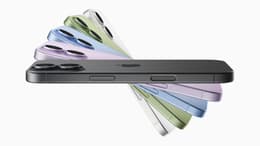The highly anticipated new iPhone 17 generation from Apple has had plenty of hype—but is it really worth yet another upgrade?
The four new versions of the iPhone—the iPhone 17, iPhone 17 Pro, iPhone 17 Pro Max and iPhone Air—have been heralded by Apple fans as the most impactful new development for the device in years.
Whether that perception extends beyond Apple fanboys depends on your tolerance for spending the best part of $1,000 on a single device, and whether you’re beholden to the iOS ecosystem.
But unlike the past several years of tinkering around the edges, Apple has released something new and different to what’s gone before. As well as new colours and hardware innovations, there’s an entirely new model to capture your attention: the ultra-slim iPhone Air. But is it worthy of all the hype?
“Early observations suggest that the Air's more compact build could mean fewer modular components, potentially making repairs more complex or costly,” warns Kewin Charron, senior lead refurbishment operations manager at Back Market.
“Real-world testing will be essential to understand how this impacts battery health, durability, resistance, and long-term reparability.”
iPhone 17 | iPhone Air | iPhone 17 Pro | iPhone 17 Pro Max | |
|---|---|---|---|---|
Battery | 30 hours video playback | 27 hours video playback | 33 hours video playback | 39 hours video playback |
Price | $799 | $999 | $1099 | $1199 |
Weight | 177 grams | 165 grams | 206 grams | 233 grams |
Storage | 256 GB or 512GB | 256GB, 512GB, or 1TB | 256GB, 512GB, or 1TB | 256GB, 512GB, 1TB, or 2TB |

What’s new in the iPhone 17 line-up?
Apple has gained a reputation—one that’s not exactly unearned—for simply slapping a slightly more powerful chip into its casing, a slightly sharper camera on the back of the device, and a slightly less sluggish operating system on the phone itself… and then calling it a new generation of iPhone.
But the 2025 releases are somewhat different. We have new names and new forms, including the ultra-thin 5mm iPhone Air, as well as new metals for the case and new colours on top of it. Here’s what you need to know about each device:
iPhone 17
The base model, which retails for $799, is much of a muchness with previous versions of the device. As with past years, the iPhone Apple unveiled this year is a small step, rather than a giant leap, in form and performance. The biggest jump you’re likely to notice as an end user is a brighter display, which is now 120Hz as standard—double the sluggish 60Hz on the standard iPhone 16, though if you’re thinking of upgrading from an iPhone 16 Pro or Pro Max, you won’t notice a difference. You’ll get smoother scrolling and brighter colours.
Usually, a better screen means a weaker screen, but here there’s no trade-off: Apple’s Ceramic Shield 2 technology is three times more scratch resistant than the iPhone 16. The front camera is also 50% better, with 18MP and a new Centre Stage selfie feature that helps take landscape selfies without rotating the phone. Those photos will also be slightly bigger—the display is 6.3 inches, compared to 6.1 on the iPhone. You get two lenses on the back, and one on the front.
Inside the chipset is just the next version of Apple’s device-specific chip, the A19, but Apple claims the iPhone 17 has a better battery life: 30 hours of video playback, compared to the 22 hours on the iPhone 16. You get double the storage (256GB) on the cheapest model compared to last year, with the option to buy a more expensive 512GB option.
But truthfully, this is the same thing you’ve seen from iPhones for the last five years or more. A slightly better version of what went before. If you’re locked into an annual replacement cycle, then sure… go for it. But otherwise, save your money. This is evolution, not revolution.

iPhone 17 Pro
If you’re someone who uses your iPhone as a replacement for a camera, and feel the need to eke out every bit of hardware and software improvement, then you might want to consider the $1,099 iPhone 17 Pro. At 206 grams, it’s 16% heavier than the basic iPhone 17. Most of that weight comes in the battery: it has 4252mAh, compared to the 3692mAh standard cell. That means you get a whopping 33 hours of professed video playback before you’re out of juice—though you can recharge to 50% within 20 minutes, Apple claims.
It retains the heat-forged aluminium body that iPhones have had for a while, though the colour options available to buyers – a silver, blue and bright orange – have raised some eyebrows. Inside it has a vapor chamber - containing deionised water designed to act as a heat sink away from the A19 Pro chip within the device - resulting in higher performance. Its USB3 connection also means you get up to 10Gb/s data transfer compared to the iPhone 17’s paltry 480Mb/s.
The display and core CPU is much the same beyond the chip, though photographers might see merit in the additional 48MP telephoto lens.
iPhone 17 Pro Max
If the iPhone 17 Pro doesn’t seem souped up enough for you, there is a further option to go even grander. The iPhone 17 Pro Max is heavier still, with a 5088mAh battery that can last you an extra six hours beyond the Pro, a whole 39 hours. If you’re upgrading from several generations back, then that can be worth it: you get 10 more hours than you would from the iPhone 14 Pro Max, released in 2022, alongside a 40% faster six-core CPU and a twice-as-quick six-core GPU.
All that extra power means extra weight, of course: the iPhone 17 Pro Max tips the scales at 233 grams, which is 15 grams heavier than the Samsung Galaxy S25 Ultra, a similarly high-specced phone. But truthfully, beyond the better battery, and a screen that’s around 10% larger than all the others so far at 6.9”, there’s not much to make the iPhone 17 Pro Max a convincing buy, unless you’re someone who just has to have the highest-end everything.
The branding is new, and some of the designs of the devices are too. But crack open the casing and Charron isn’t convinced there’s all that much different from the current crop of iPhones and what has gone before. “There are no breakthrough technologies in these updates,” he says. “The improvements remain incremental, aimed at polishing the experience rather than redefining it.”
iPhone Air
The closest that statement about no breakthroughs comes to potentially being proven wrong is with the iPhone Air. Long-rumoured and much talked about, the Air does feel—slightly—like a shift in what the iPhone is. At just 165 grams, it’s 30% lighter than the iPhone 17 Pro Max, and at just 5.64mm thick, it feels far stranger in the hand than the other devices.
The rumours before the release of the device were that this was Apple laying the ground for a foldable, and with the form factor of the phone totally different—including loading all of its actual hardware and gubbins into a small section near the top of the single lens on the back of the camera.
There’s more RAM in the Air than the stock iPhone 17—12GB compared to 8GB—but the thinness of the whole thing does require some compromises. The battery is 3149mAh, which still puts it favourably in comparison to other manufacturers’ products, but feels underpowered for this generation of iPhones. Apple knows it too, offering a wireless battery pack that you can attach to the back of the device to keep the juice going when you need it.
“As with the iPhone Air, real-world testing will still be important to validate Apple's claims around battery life, durability, and long-term reliability,” adds Back Market’s Charron. But even there, the form factor requires compromise: rather than the 25W Qi2 wireless charging you have on every other device in this set of gizmos, you get 20W.

How easy is each device’s battery to replace?
One of the biggest criticisms of the iPhone—and any Apple device, really—was nullified somewhat with the release of the iPhone 16 last year, and the ability to remove the battery by debonding the adhesive tape glueing the battery to the phone using an electrical current. But even then, are you really willing to go to all that effort?
Probably not, and Apple knows—which is why they manage to keep users locked into their repairs programme. Apple remains a tricky company for anyone looking to tinker or test their device in a non-standard way. When you’re considering what device to spend your cash on, you have to think about what the longer-term, ongoing costs of having that device are—and with an iPhone, you’re rarely if ever able to just buy a battery if its charging power starts to wane.
Stick or twist with a new device?
Apple’s pomp and circumstance around its annual Cupertino events can often instil a sense of FOMO into consumers. The latest and greatest model is one we’re meant to yearn for, and opt into the annual upgrade cycle. But we don’t need to accept that, either. Apple can release its new models—and it can swap between tinkering around the edges and more significant upgrades, like the iPhone Air represents this year—but we don’t need to open our wallets just for the sake of it.
Beyond the Air, you’re looking at more of the same here, and only slightly better versions of what’s come before. And - via Back Market - you can get basically the same device, just a year or two older, with similar specs, that are refurbished by experts and add to a circular economy that actively helps lower e-waste (the latter something projected to rise by another 20 million tonnes by 2030).
Yet if you do ultimately feel the need to upgrade to one of the new models, it’s imperative you use a service like Back Market to ensure your old model is refurbished and adds to the circular economy rather than ending up in a landfill.
Charron’s conclusion? “For now, while the Air shapes the future direction of iPhones, previous models remain a dependable and more affordable option, with proven performance.”

